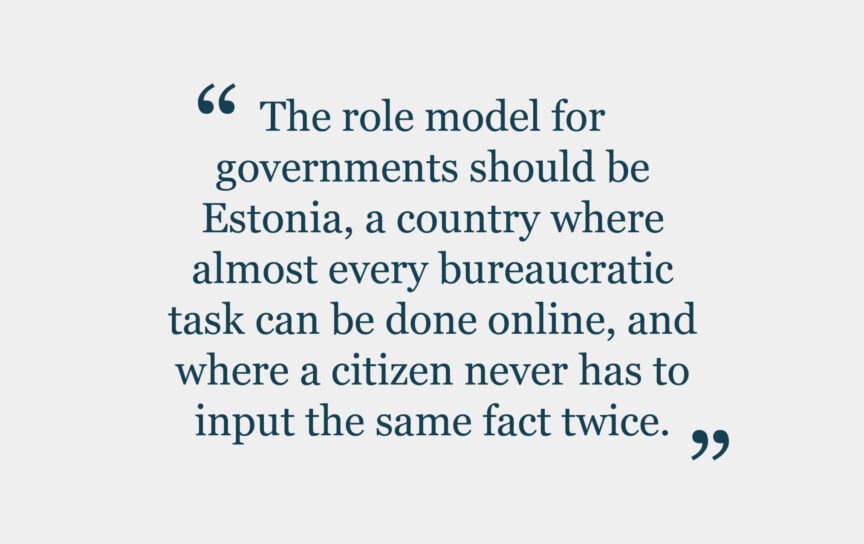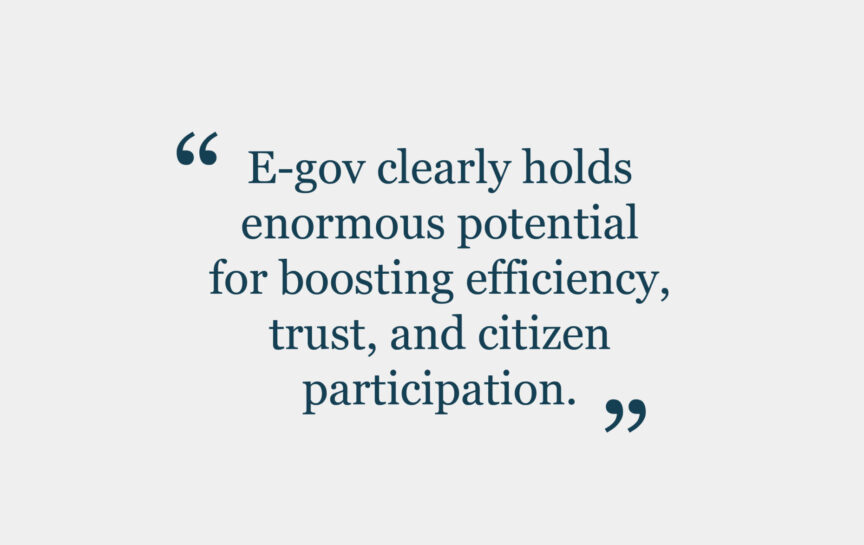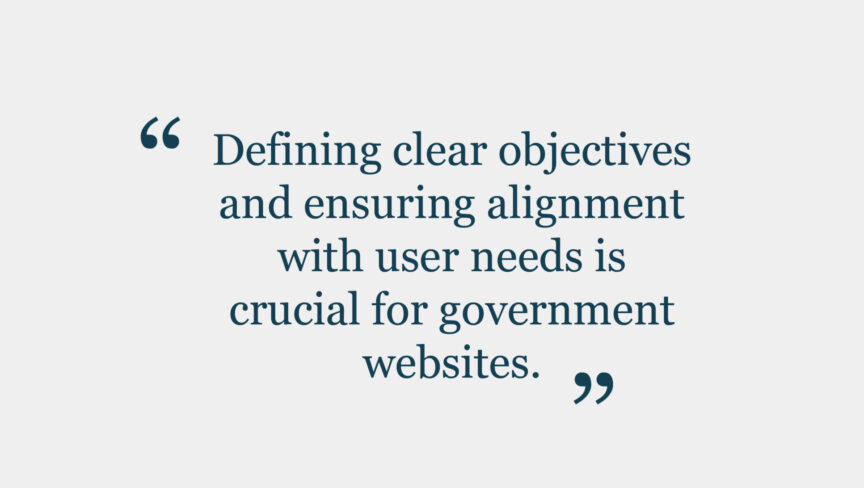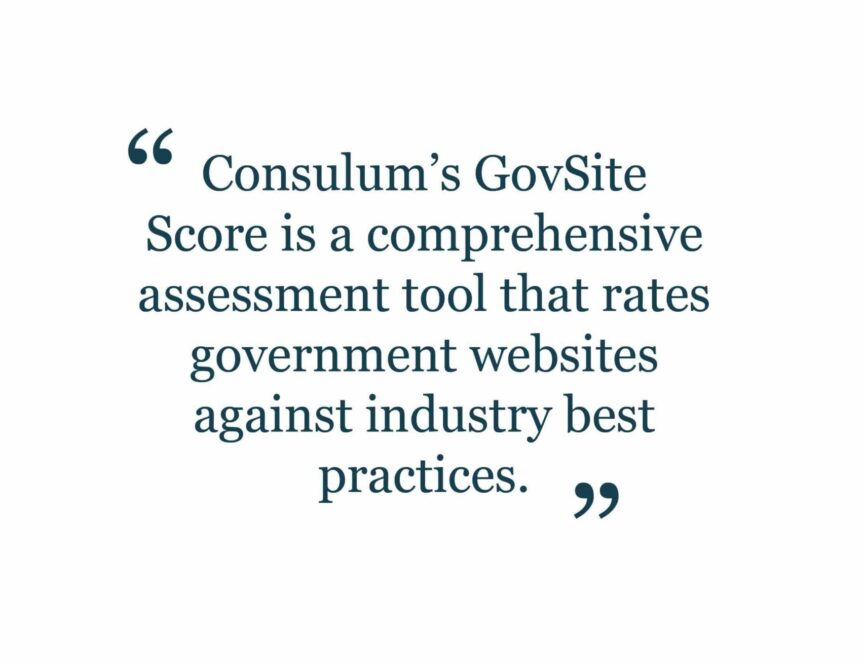Government websites:
Trust, transparency and competence
By Alan Griffin and Mayank Mittal

Evaluating and building world-class government websites
“I should have called the Estonians when we were setting up our healthcare website.”
Barack Obama, 20141
Back in the 1990s, the tiny, resource-strapped, newly independent country of Estonia recognised a remarkable opportunity: to build a digital republic from scratch. So was born “E-Estonia”, a cutting-edge system based on accessibility and efficiency. Since its inception in 1998, E-Estonia has put 99% of its public services online.
The move has benefitted the country in countless ways. The government claims that digitization of public services saves more than 1,400 years of working time and the equivalent of 2% of GDP annually.2 And indeed, real GDP per capita has risen this century, reaching the threshold of developed countries such as Greece and Portugal in 2022.3 4 Further, in an era when trust in public services is declining, Estonia achieves one of the highest “trust in government” ratings in the EU.5 Many credit this flourishing progress, in part, to Estonia’s e-gov programme and the effective utilization of information and communication technologies (ICT).

Websites are no small part of this success. Today, the Estonian government portals are admired for their user-friendly design and effectiveness.6 7 8 9 As the Financial Times gushed in 2021, “The role model for governments should be Estonia, a country where almost every bureaucratic task can be done online, and where a citizen never has to input the same fact twice.”10
E-gov clearly holds enormous potential for boosting efficiency, trust, and citizen participation. Digitization of public services is increasingly prevalent and important, and web design is a key component of this: what once were simple information depositories have evolved into powerful platforms, vital for service delivery.
But not all governments recognise the importance of websites or understand how to make a great one. The task can be rather more challenging than commercial web design. To aid in this, Consulum has created a tool for measuring the effectiveness of government websites – and uncovered some winning web strategies in the process.

The power of winning websites
Studies have shown that e-gov strategies directly affect citizen satisfaction – and trust in government in general. The most basic function to get right, whether at local, ministry or national level, is ensuring that citizens can easily access and understand information – such as press releases and legislation announcements. Increasingly, government websites also provide a range of essential services such as passport applications, license renewals, and easy tax payments. When governments provide these services transparently, effectively and securely, public trust is built and maintained.11
Indirectly, government websites – as part of a vibrant ICT infrastructure – have also proved to be excellent tools for attracting foreign direct investment (FDI). This is because good e-government lowers the costs of doing business by boosting efficiency, easing information flow, reducing processing times, and slashing red tape and opportunities for corruption.12

Tackling unique challenges
But these gains are not won easily. Government website designers face challenges over and above what their counterparts in the commercial or NGO spheres encounter. Commercial sites are not always the right models for government sites, and traditional web design skills are not automatically applicable.
Defining clear objectives and ensuring alignment with user needs is crucial for government websites. Given the diverse range of services and vast information they must provide, governments face the challenge of creating websites that effectively communicate with a wide audience. Each website should have a distinct goal, purpose, and objectives, while prioritizing accessibility and delivering clear, relevant, and valuable content to users.
Government websites also tend to involve a particularly complex set of objectives, bureaucratic hurdles and stakeholder interests. They are plagued by outdated IT infrastructure and interfaces that fail to meet contemporary user expectations and may integrate poorly with new technologies. For example, 40% of US government websites aren’t mobile friendly. At present, the United States government is in the throes of updating more than 10,000 of its webpages to resolve such issues. Government websites may also need to integrate payment platforms, and their user interface, design, and technical performance must be fit-for-purpose to enable them to fulfil their diverse range of aims and objectives as effectively as possible for as many users as possible.

Finally, these websites must outperform their civilian counterparts in the crucial areas of security and accessibility:
- Cybersecurity must be flawless. Government websites handle a wealth of sensitive and confidential information – a plum target for hackers. Security breaches can have devastating nation-wide consequences. For example, in 2018, India suffered a significant data breach related to its Aadhaar biometric identity system, accessed online via the UIDAI Aadhaar Services page, which allowed unauthorized access to highly personal user information.13
- Nobody gets shut out. Uniquely, government websites cannot be narrowly targeted: at the national level they need to reach an entire populace. That means being as widely accessible as possible, including to those who may face obstacles getting online, such as the elderly, the disabled, or those in remote locations.14 Mobile accessibility is also a key concern as the share of mobile web activity continues to grow worldwide. This is a particular concern in emerging economies in Africa and Asia where a large majority of people primarily access the internet using mobile devices.15
Indeed, in some countries this accessibility is legally mandated: in the United States, government websites must comply with the Americans with Disabilities Act, while in the UK the Department of Justice requires compliance with their recently implemented Web Content Accessibility Guidelines (WCAG)1.
Still, many countries fall short: one recent study evaluating hundreds of e-government websites from Sub-Saharan African countries found that almost all had inadequate usability. But poor accessibility is a persistent problem in even well-resourced countries: for example, around ten percent of US federal websites are not fully accessible for people with disabilities.2
To meet these challenges and reap the benefits, governments must be able to evaluate the effectiveness of their current websites, measured against global standards. So where does your website fall, on a quality scale of nought to Estonia?

The Consulum GovSite Score: Introducing a comprehensive website assessment tool
Consulum’s GovSite Score is a comprehensive assessment tool that rates government websites against industry best practices. Its robust, cross-cutting metric highlights key performance indicators across websites with diverse objectives, pinpointing areas for improvement. Scoring criteria include:
-
- Technical performance. Government websites need to perform flawlessly while meeting their diverse range of objectives. Our GovSite score assesses key indicators of technical performance, including speed, bounce rate, SEO optimizations, security, and mobile friendliness.
- Accessibility. Government websites need to cater to a diverse range of citizens, including those who may face obstacles in engaging with the site, such as the elderly or those with disabilities. The GovSite score measures a website’s accessibility (including aspects such as screen reader accessibility for the blind or UX, design, and readability for the visually impaired) and compliance with top international standards.
- Functional and aesthetic design. Government websites need to be designed to facilitate seamless user experiences, while also having an excellent look and feel to facilitate user engagement and confidence. To assess this, Consulum’s GovSite score assesses aspects including user journey, ease of navigation, and how visually appealing the website is, as well as how the design facilitates excellent user experience.
How do today’s government websites perform?
We applied our GovSite scoring methodology to a representative sample of government websites (15 government websites covering all regions with varying levels of economic prosperity), some of which aim to provide services to citizens and visitors while others seek to attract investment into their respective countries (Figure 1). These scores can form the basis for a thorough evaluation of the website and how well it is serving its audience.
Technical performance was identified as a key challenge facing government websites across the world. The technical performance of these websites is a primary concern, as basic functionality is needed to allow citizens to interact with the websites and ensure that crucial services and information can be accessed seamlessly. Our GovSite assessment shows that many governments may need to closely monitor their sites’ performance and ensure that they function effectively to avoid technical issues, preventing the websites from fulfilling their purpose and objectives.
Accessibility varied widely across websites, with some scoring highly while others lagged behind. Accessibility is perhaps a greater concern for services websites, as these need to reach all citizens, some of whom may face barriers. Government websites should ensure that they meet key international standards for accessibility to ensure access for all.
Design and user journey tended to be similar across websites, with few standing out as frontrunners in this area. The middling scores in this area highlight the need for government websites to be built with functional and aesthetic design, as well as the opportunity for excellent sites to differentiate themselves by providing a seamless, easy, and aesthetically pleasing journey for their users.

Our analysis revealed some interesting results about government websites across the world:
1. Germany Leads in Overall Performance:
Germany ranks highest with an overall score of 8.3, demonstrating strong technical performance, accessibility, and design/UX. Notably, its user distribution between mobile (57%) and desktop (43%) is relatively balanced compared to countries like Singapore (71% mobile), indicating that Germany’s government website effectively caters to both device types. This highlights the importance of ensuring seamless experiences across platforms.
2. Mobile dominance across most countries necessitates a mobile-first approach:
Across all countries, mobile traffic surpasses desktop usage, with extremes such as Nigeria (93.6% mobile) and Estonia (88.1% mobile). This reinforces the need for governments to adopt a mobile-first approach, ensuring their websites are optimized for performance, accessibility, and usability on smaller screens, especially in regions with limited desktop access.
3. Performance scores do not always correlate with high traffic:
Countries with lower overall scores, such as India (3.7) and Spain (5.4), still experience substantial mobile traffic (8.3M and 1.8M users, respectively). This suggests that despite lower ratings in technical performance, accessibility, or UX, their government websites remain widely used. The high traffic levels underscore the urgency for performance improvements to enhance user experience and service delivery.

Strategies for building excellent government websites
Equipped with GovSite insights, Consulum has constructed several strategies for building world-class government websites that foster greater citizen trust and engagement. When designing government websites, there are several key considerations that must be kept in mind:
- Government websites must clearly define their purpose, aims, and objectives. The website must also align with the strategic vision of the relevant government body and must be built to ensure that these aims and objectives can be met while furthering their strategic vision.
- Technical performance must be flawless and must be monitored carefully and continuously to ensure that the website functions as intended for both – desktop as well as mobile versions.
- Websites must be built with accessibility in mind from the beginning and must aim to be accessible to the widest range of citizens possible. Websites must meet domestic legal requirements and should aim to meet key international standards.
- User experience is a key concern, especially given the diverse range of services and information offered by a typical government website. Continuous assessment of user experience, including gathering feedback from users, is key to ensuring easy and seamless user journeys.
- Aesthetic design is an often-overlooked aspect of government websites. Government websites should aim for a clean and consistent design that inspires confidence in users.
***
Our GovSite score can help governments gather valuable information on how well their websites perform relative to international peers, as well as identify areas that may need improvement. However, to properly assess how effectively a website is fulfilling its purpose and objectives, a more detailed analysis would be needed. In particular, gathering and evaluating feedback from citizens is key to determining how the intended users actually interact with the website, and what their experience is like. Consulum’s tools and expertise allow us to dive deeper into government websites and determine exactly what it would take to make them world-class.

About the authors
Alan Griffin
Alan Griffin is a Consulum Partner and Head of the company’s Digital Practice. He advises government organisations on integrated strategic communications, social media, digital infrastructure, digital transformation, emerging technologies and innovation. Prior to joining Consulum, Alan held senior digital roles at The Financial Times, Reuters, Forbes and The National. He was the first person in the Middle East to be awarded an innovation grant from Google.
Mayank Mittal
Mayank Mittal is a Senior Director at Consulum. He spearheads the development of cutting-edge digital infrastructure solutions that elevate clients’ capabilities. He has over 15 years of experience in product development, innovation and agile practices. Prior to joining Consulum, Mayank led transformative strategic initiatives at global organisations such as BCG, Toyota, Kraft Heinz, GE, and Emirates Group. He is also the founder of two tech startups.
References
1. Khan, Imtiaz and Shahaab, Ali, (2020, Oct 7). The Conversation.com Estonia is a ‘digital republic’ – what that means and why it may be everyone’s future
2. Boltho, A, (2020). Baltic Journal of Economics, 20(1), 74–93, Southern and Eastern Europe in the euro-zone: Convergence or divergence?
3. Szentmihalyi, Szabolcs (2023). Magyar Nemzeti Bank (Central Bank of Hungary), vol. 22(1), pages 143-158. “Digitalisation and convergence – The Example of Estonia,” Financial and Economic Review.
4. Trust in Government, OECD, 2022.
5. Price Waterhouse Coopers, 2019. Estonia – The digital republic secured by blockchain
6.Meskell, Darlene, (2014. Dec 31), Digital.gov, The best e-gov websites in the world
7. Rathic V Gopal, Medium, December 19, 2022. “Aadhaar data breach — How sensitive data of 1.3 billion Indians was compromised”
8. Gifford, M (2022, March 18). Govloop.com, 4 Accessibility mistakes plaguing most government websites
9. “Mobile internet usage worldwide – Statistics & Facts,” Statistica, 2024.
10. Silas Formunyuy Verkijika, Lizette De Wet, (208) Volume 39, Pages 20-29, ISSN 0268-4012, International Journal of Information Management, A usability assessment of e-government websites in Sub-Saharan Africa
11. Ali J. Al-Sadiq. (2021). The Role of E-Government in Promoting Foreign Direct Investment Inflows. IMF Working Paper. https://www.imf.org/-/media/Files/Publications/WP/2021/English/wpiea2021008-print-pdf.ashx
12. Eric W. Welch, Charles C. Hinnant, M. Jae Moon, Linking Citizen Satisfaction with E-Government and Trust in Government, Journal of Public Administration Research and Theory, Volume 15, Issue 3, July 2005, Pages 371–391, https://doi.org/10.1093/jopart/mui021
13. E-estonia, We have built a digital society & we can show you how, accessed 20.11.2024
14. Pedak, M. (2013). eID Estonian experience. Nederlandse Vereniging voor Burgerzaken/ Dutch Association for Civil; Victor I. Espinosa & Antonia Pino (16 Feb 2024): E-Government as a Development Strategy: The Case of Estonia, International Journal of Public Administration, doi: 10.1080/01900692.2024.2316128
15. Kuper, Simon (2021, June 24), ft.com, Good things happen when governments work from home
